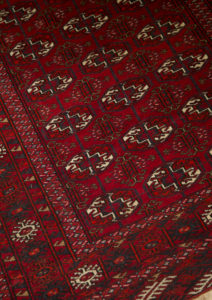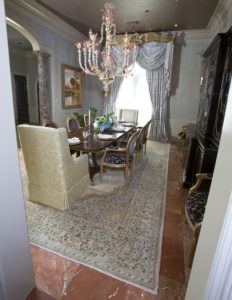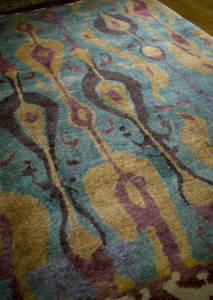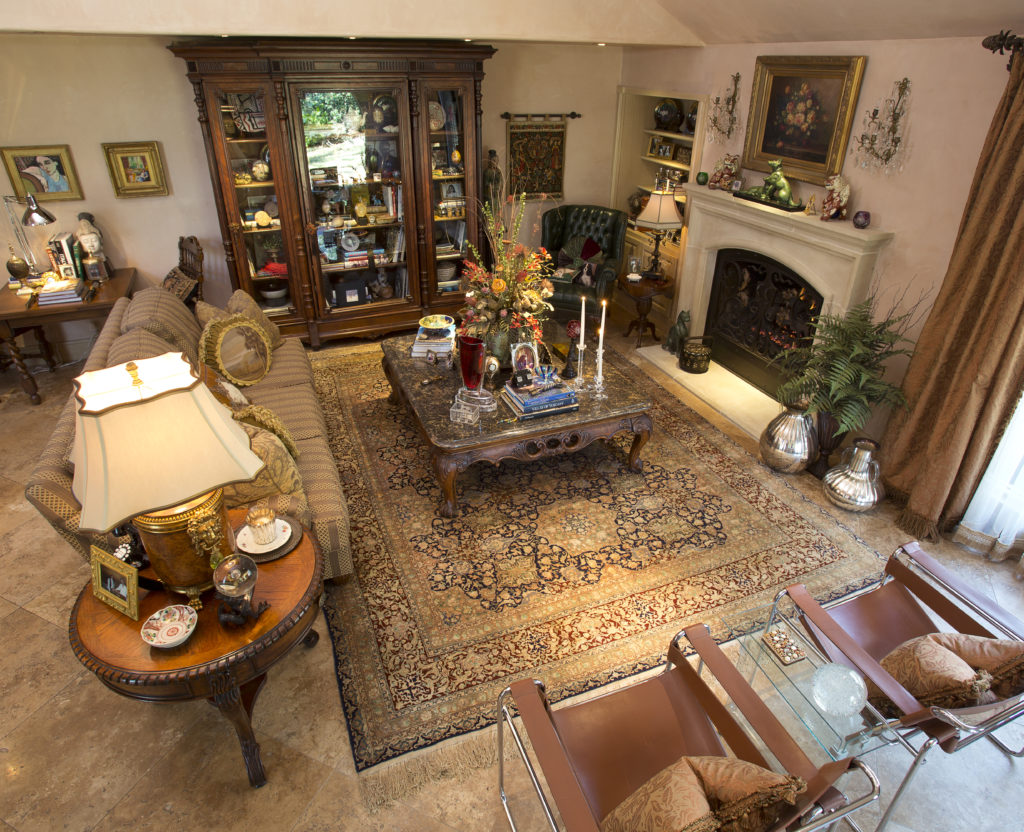INDULGE Design Feature — Woven Tapestries
WITH THEIR RICH HISTORY AND DISTINCTIVE DESIGNS,
ORIENTAL RUGS ADD ARTFUL ELEGANCE TO ANY ROOM IN THE HOME.
By Elaine Rogers
Persian carpets and other “rugs of the East” are firmly established as elegant design elements — subtle and often-unheralded — that loudly whisper refinement and good taste.
Historically, many of us think of them in terms of the imagery of medieval Europe: They were considered great status symbols in the 1500s and, some 200 years beyond, were too precious to put on floors; instead, they adorned tables, chests and walls.
But the story of Oriental rugs goes back so much further — try 3,000 B.C., when Nomadic tribes in Mongolia and Turkey used hair from their camels and sheep to weave carpets to keep their earthen floors warm, and 1,000 B.C., when rugs with an impressive 300 knots per square inch were already in existence.
In Persia, especially, the artistry of the carpet developed so much that, today, a dizzying variety of distinctive patterns and styles is linked to at least 40 rug-making Iranian cities or villages.
Oriental rugs have been prominently depicted in literature, art and music for thousands of years.
“We have a long history of admiring Oriental rugs,” says Fort Worth interior designer Joe Minton. “They’re a beautiful thing to use in a room. I just really love them and I’ve come to know a lot about them because I have used them in my business for 40 years. … I like to educate people about them.”
Connections To The Past
My curiosity about Oriental rugs is of a sentimental variety: I have an oddly conflicted relationship with a Persian carpet I was given as a child. There’s the pride of ownership, of course, but also discomfort — the latter, because my mind boggles at the idea of people toiling away at looms, tying tiny knots all day to weave these intricate patterns of Persian florals onto artistic tapestries that others might tread upon with nary a thought. (Child labor is an issue that the industry still grapples with, especially in India, Pakistan and Afghanistan, recent reports have shown.)
A true Oriental rug is “hand-knotted,” woven one knot at a time — a tribute to the patience and craftsmanship of the weavers. The terms “hand-tufted” and “handmade” are misleading — those can still be machine made. It is said that the average weaver ties as many as 10,000 knots per day, and a 9-by-12-foot Persian rug that has 500 knots per square inch takes four or five artisans, working six hours a day and six days a week, about 14 months to complete.
My medium-sized, cream-colored creation is a Kashan, I’m told, and like me, it is, at least, a semi-antique. It was jokingly dubbed my “dowry rug” when my dad purchased it several decades ago during a two-year period that our family lived in Iran. I was 13, an age when many Iranian girls from wealthy families — in a not-so-distant past — were routinely married off to old men of their fathers’ choosing.
Although I treasured this exotic souvenir of time spent abroad, I also tucked it away for decades — seldom using it, walking upon it or inviting others to do so. It’s a decision that folks with strong footholds in the rug-making world call “a crying shame.”
“Rugs are like paintings,” says Ben Shabahang, owner of Shabahang Empire Rugs in Southlake. “It’s art. But that doesn’t mean you tuck it away and ignore it.” Working himself up to something between a gentle admonishment and a good-natured scolding, he adds: “These types of carpets are meant to be USED. Used and worn and enjoyed forever.”
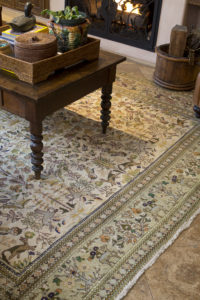
An intricately-patterned Persian carpet in the home of designer Dennis Waters in Southlake, Photo by Ross Hailey.
Tom Siasi of CT Rugs in Fort Worth agrees: “I always say rugs are a little bit like humans. If you rolled me up and put me in the corner, my back would hurt. … Unused rugs can get mildewed and musty-smelling, and sometimes you can never get those smells out.”
In his own home, Shabahang says, he keeps Oriental carpets in just about every room of the house. “They’re everywhere, and they’re all different styles,” he explains.
“Each one is beautiful in its own way. They give me and my family enjoyment every day because we use them. … What other kind of artwork can you walk on and know that it just keeps getting better?”
Age & Beauty
When my family first arrived in Tehran, of the many new sights and sounds encountered, perhaps none was more startling than the daily drama of merchants flinging their carpets on the filthy roads in front of their shops so that the speeding taxis and motorists would drive over them, accelerating their wear-and-tear quotients with muddy tire tracks.
From a Western perspective, it was sheer insanity, but we were soon told that an appreciation of floor coverings with a soft, cushy pile was an American eccentricity, and old, threadbare Persian carpets were most prized in this culture — thus, the vendors wanted their fresh rugs to look like antiques and fetch a better price.
Many a Westerner swerved and stopped to avoid soiling the roadway rugs, and the merchants would come out to the curbs and gesture wildly, beckoning the foreign motorists to put tire tread on their carpets to help improve their beauty.
Perhaps in Iran and other corners of rugmaking countries such as China, Nepal, India, Pakistan and Afghanistan, some merchants might still use urban roadways to age rugs prematurely, but newer antiquing processes like acid-washing and leather-whipping are decidedly more common — and effective.
Meanwhile, industry insiders say it’s almost impossible for a layperson to tell the difference between an antique rug and a newer one that’s been antiqued.
“You can’t tell at first glance. You have to look carefully,” says Minton. “I had a client recently who didn’t like a certain rug because he thought it looked too old, and I said, ‘That’s funny, because this one is actually new, so I guess somebody really did their job well.’ I also saw a new one recently where they put a tear in it, then mended it, so that it would look like an antique. If you don’t know anything about them, you need an expert who knows what they’re doing to guide you.”
“A lot of good antiquers are just that good,” Shabahang agrees. “They can make a new rug fresh off the loom look very, very old, and no one can tell the difference. That’s why you’ve got to deal with people who are reputable and who you trust.”
Artistic Deviations
At first glance, my Persian carpet is a twin to one that resides in California with my sister. Our dad purchased them together, and they bear the trademark elongated center medallion surrounded by vines and Persian florals that make them instantly recognizable as products of the city of Kashan to those in the know. Of course, the symbolism and history of the intricate pattern were lost on us, the artistry of the weavers a hard thing to fathom.
Our dad hung the carpets on the wall of a bedroom through our teen years, and my sister and I discovered many miniscule differences between them. We would trace the delicate patterns of vines and blossoms with our fingers, lovingly pinpointing the places where one weaver made a flower using mint thread while her counterpart selected yellow or green.
Whether mistakes or artistic deviations, these types of “flaws” are a hallmark of Oriental rugs: Two women from a nomadic tribe might start weaving a rug from opposite sides, adding their own touches as they work, while weavers of Persian prayer rugs are known to purposefully weave irregularities into their creations — a little speck of bright orange in a rug full of browns, for instance — as a reminder that humans cannot duplicate the perfection of Allah.
As for my old visions of children toiling away to make my rug — and other rugs like it — Shabahang and other local rug retailers say it’s important for rug retailers to research their suppliers and, similarly, for consumers to find rug dealers whom they trust, to ask questions about their carpet sources and not to be comfortable with retailers who give evasive, vague or inadequate answers.
A third-generation rug dealer and entrepreneur, Shabahang says he eliminated the child labor issue from his business by opening small factories of his own in India and “completely cutting out the middleman.” His operations reportedly house about 40 looms and produce Persian-designed rugs the old-fashioned way, with two to four people working each loom.
Taking a different approach, Hassan Khoshroo, owner of Atlas Rugs in Fort Worth, says he travels to India and elsewhere to check on his suppliers’ factories and view the work conditions of the weavers.
“You never really know what things are like if you only visit them when they know you are coming,” Khoshroo explains. “I pay them surprise visits. I just drop by unexpectedly. That’s how you find out what’s going on over there.”
Meanwhile, Siasi of CT Rugs says he never worries about industrialization or the growing market for mass-produced Oriental carpet “knock-offs” eliminating the ancient techniques of making hand-knotted rugs. Noting that “they’re two different markets,” he says nothing can replace the allure of a “real” Oriental rug like mine.
“You never see an antique Persian carpet at the Goodwill,” he says. “People keep them in the family and pass them on through the generations. They’re classics.”
So, it’s time for my dowry rug to come back out into the light. I’ve resolved that if I can’t bring myself to walk on it daily, to flatten its soft pile with everyday usage or to expose it to the insensitivities of my household’s curious cats, I can at least mount it on a tall wall in my entryway and gaze upon it as I journey out into the world and back again.
If my rug is once again in full view, I’m sure I’ll stop from time to time to admire the intricacies. Plus, I’m overdue for sharing some of what I know of its history with my kids, who just might enjoy tracing the vines and searching out a few of those intriguing flaws.
* * * * * * * *
Child labor is an issue that the rugmaking industry still grapples with, especially in India, Pakistan and Afghanistan, and organizations like GoodWeave International attempt to combat the issue with a certification program that identifies manufacturers that voluntarily comply with the nonprofit organization’s child-labor free standards.
Look for the GoodWeave certification seal on Oriental rug labels and ask retailers about their compliance with the program. Learn more at www.goodweave.org.

